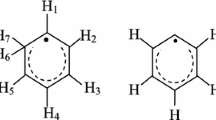Abstract
THE electron paramagnetic resonance spectrum given by polymethyl methacrylate after high-energy irradiation at room temperature consists of five lines, about 23 gauss apart, with intensities in approximately the ratios 1 : 4 : 6 : 4 : 1, with a weaker intermediate pattern of four lines, both closely centred on the electron spin g factor of 2.001,2. Since this spectrum is also given by free radicals trapped during the addition polymerization of methyl methacrylate3–5, it has been postulated that it arises from trapped propagating radicals of structure, —CH2— C(CH3)CO2CH3, the detailed explanations involving the exact conformation of these radicals2,4,6. Both of the explanations put forward by Symons4,6 require that the methyl group bonded to the ‘radical’ carbon atom rotates rapidly, so that its three protons interact equally with the unpaired electron. If one of these explanations is correct, the hyperfine structure of the spectrum should alter when the temperature is lowered sufficiently. The rotation of the methyl group might change to a torsional oscillation, thus destroying the equivalence of the three methyl protons. If however the rotation remains free, at a temperature where only the lowest rotational level is populated, symmetry conditions will govern the occupation of the nuclear spin levels.
Similar content being viewed by others
References
Schneider, E. E., Disc. Farad. Soc., 19, 158 (1955).
Abraham, R. J., Melville, H. W., Ovenall, D. W., and Whiffen, D. H., Trans. Farad. Soc., 54, 1133 (1958).
Fraenkel, G. K., Hirshon, G. M., and Walling, C., J. Amer. Chem. Soc., 76, 3606 (1954).
Ingram, D. J. E., Symons, M. C. R., and Townsend, M. G., Trans, Farad. Soc., 54, 409 (1958).
Atherton, N. M., Melville, H. W., and Whiffen, D. H., Trans. Farad. Soc., 54, 1300 (1958).
Symons, M. C. R., J. Chem. Soc., 277 (1959).
Ingram, D. J. E., “Free Radicals as Studied by Electron Spin Resonance” (Butterworths, London, 1958).
Townes, C. H., and Schawlow, A. L., “Microwave Spectroscopy” 69 (McGraw-Hill, New York, 1955).
Author information
Authors and Affiliations
Rights and permissions
About this article
Cite this article
OVENALL, D. Electron Paramagnetic Resonance at 4.2° K. of λ-Irradiated Polymethyl Methacrylate and Polymethacrylic Acid. Nature 184, 181–182 (1959). https://doi.org/10.1038/184181b0
Issue Date:
DOI: https://doi.org/10.1038/184181b0
- Springer Nature Limited
This article is cited by
-
Dependence of EPR spectra of free radical species in polymethylmetacrylate on γ-irradiation dose
Czechoslovak Journal of Physics (1961)




